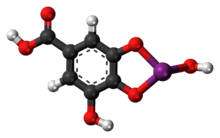Bismuth subgallate
 | |
 | |
| Clinical data | |
|---|---|
| AHFS/Drugs.com | International Drug Names |
| ATC code | A07BB (WHO) |
| Legal status | |
| Legal status |
|
| Identifiers | |
| |
| CAS Number |
99-26-3 |
| PubChem (CID) | 16682999 |
| ChemSpider |
10607905 |
| UNII |
YIW503MI7V |
| ChEBI |
CHEBI:31292 |
| Chemical and physical data | |
| Formula | C7H5BiO6 |
| Molar mass | 394.091 g·mol−1 |
| 3D model (Jmol) | Interactive image |
| Density | 1.1 g/cm3 |
| |
| |
| | |
Bismuth subgallate, with a chemical formula C7H5BiO6, is commonly used to treat malodor by deodorizing flatulence and stools. In the United States it is the active ingredient in Devrom (internal deodorant), an over-the-counter FDA-approved medicine. Also, it has been used to treat Helicobacter pylori infection and is used in wound therapy. As an internal deodorant, it is commonly used by individuals who have had gastrointestinal stoma surgery, bariatric surgery, fecal incontinence, and irritable bowel syndrome.[1]
Also, a double blind study in 1974 reported its effectiveness as a flatulence/stool deodorant in ileostomy patients.[2]
Adverse effects
It can cause darkening of the tongue and stools, which is temporary.[3]
In 1974, a reversible encephalopathy was noted and examined in four colon cancer patients taking bismuth subgallate after abdominoperineal resection.[4]
Bismuth subgallate is contraindicated in case of hypersensitivity to the substance, and should be used with caution in people with liver disease or kidney disease.[3] It is grouped in pregnancy category C[3] (risk not ruled out: Animal reproduction studies have shown an adverse effect on the fetus and there are no adequate and well-controlled studies in humans, but potential benefits may warrant use of the drug in pregnant women despite potential risks). During lactation, very little bismuth subgallate passes over to the child.[3]
See also
External links
- American Cancer Society: Ileostomy Guide
- Cleveland Clinic-Having an Ileostomy– A Primer for New Ostomates
- The Ostomy Files:The Issue of Oral Medications and a Fecal Ostomy
- Devrom website
- Gulp: Adventures on the Alimentary Canal by Mary Roach [6]
References
- ↑ Gorbach S. L. (1990). "Bismuth therapy in gastrointestinal diseases". Gastroenterology. 99 (3): 863–75. PMID 2199292.
- ↑ Sparberg M. (1974). "Correspondence: Bismuth subgallate as an effective means for the control of ileostomy odor: a double blind study". Gastroenterology. 66 (3): 476. PMID 4813513.
- 1 2 3 4 "Bismuth subgallate (OTC) Devrom". Medscape. Retrieved 2015-12-02.
- ↑ Burns R.; Thomas D. W.; Barron V. J. (1974). "Reversible encephalopathy possibly associated with bismuth subgallate ingestion". British Medical Journal. 9 (1): 220–3. PMC 1633100
 . PMID 4818163.
. PMID 4818163.